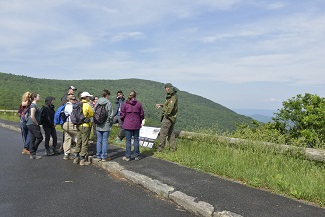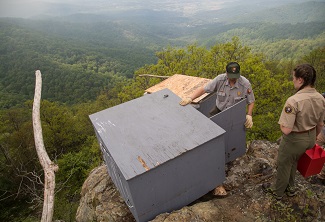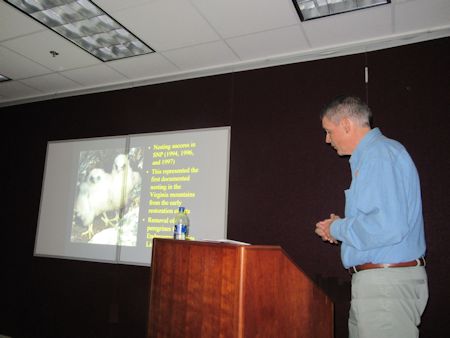On March 1, 2020, Shenandoah National Park biologist Rolf Gubler described the peregrine falcon (Falco peregrinus) restoration project to a packed room of 80 enthusiasts. This project in the park is a partnership of the National Park Service (NPS), William and Mary College’s Center for Conservation Biology (CCB), the Virginia Department of Game and Inland Fisheries (DGIF) and the Virginia Department of Transportation (VDOT).
 NPS biologist Rolf Gubler is a team member on the peregrine falcon restoration project.Biologists bring peregrine falcon chicks from eastern Virginia bridge nest sites to the park’s high ledges, part of Virginia’s central Appalachian Mountains and once part of the birds’ historic range. Scientists hope the peregrines will imprint on the park's cliffs and return as breeding adults in two to three years, Gubler explained.
NPS biologist Rolf Gubler is a team member on the peregrine falcon restoration project.Biologists bring peregrine falcon chicks from eastern Virginia bridge nest sites to the park’s high ledges, part of Virginia’s central Appalachian Mountains and once part of the birds’ historic range. Scientists hope the peregrines will imprint on the park's cliffs and return as breeding adults in two to three years, Gubler explained.
Peregrines are found in rural and urban environments and on every continent except Antarctica. They perch and nest on cliffs, skyscrapers, water towers and other tall structures where mammalian predators cannot reach them. Highly territorial, they make nests usually seven to ten miles apart.
They use river systems and coastal areas where there is a reliable prey base. First-year mortality can be as high as 71 percent because the young birds die from collisions with utility wires and glass windows, storms, starvation and great horned owls.
In mid-June, people may be able to see the young birds in the park from the overlook at milepost 49.
The March 1 program was sponsored by FODM, the Audubon Society of Northern Virginia, the Northern Virginia Bird Club and the Virginia Society of Ornithology
You can learn more at https://www.nps.gov/shen/learn/nature/falconhacking.htm.
 Rolf Gubler talks to group at overlook in Shenandoah National Park. Rolf Gubler talks to group at overlook in Shenandoah National Park. |
 Scientists use hack boxes to raise young peregrines on mountain ledges in Shenandoah National Park. Scientists use hack boxes to raise young peregrines on mountain ledges in Shenandoah National Park. |


